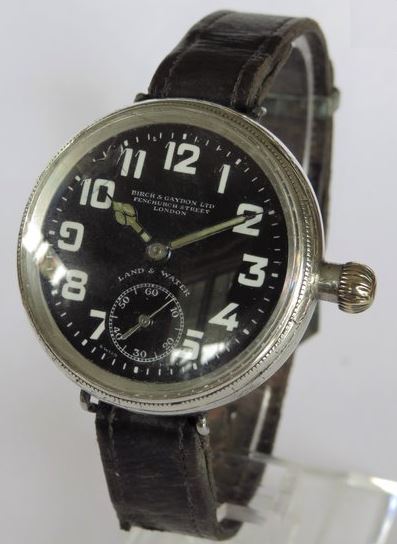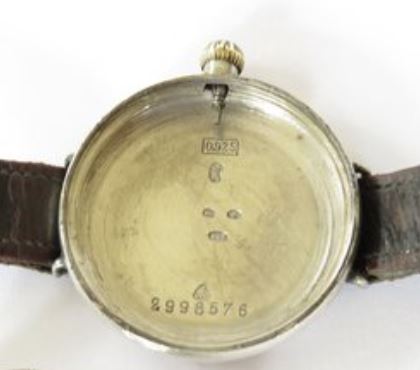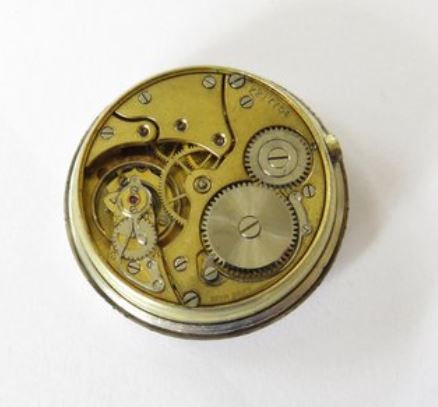Last updated on April 27, 2024
One of the watches high on my wish list is the Land & Water trench watch, made by Zenith and retailed by Birch & Gaydon. This is the perfect example, but unfortunately, by the time I had stumbled across the listing the watch had already sold for an unreported amount. It comes from a highly respected watchmaker, Zenith and was branded for and sold by one of the most prominent jewellers of the period, Birch & Gaydon. Even though the watch was no longer available I couldn’t resist sharing my research on this particular timepiece.
Trench watch
A trench watch is a type of wristwatch that became commonly used by soldiers during World War I. Although, they actually were first used some years earlier during the Boer Wars. Pocket watches were totally impractical for use in battle. Trench watches were intended to be durable and reliable, with features such as water-resistant cases and luminous dials that would make them usable in the challenging conditions of the trenches. Trench watches were also often equipped with leather or fabric straps that were easy to wear and adjust in the field.
Zenith
In 1865, Georges Favre-Jacot, a 22-year-old watch apprentice, founded his own watch company in Le Locle, Switzerland, which he named “Fabrique des Billodes” after the district where it was located. The Zenith brand name, which the company is now known for, was not officially registered until 1911. Initially, Favre-Jacot produced watches in a small workshop, but over the next decade, he observed the growth of the watchmaking industry in the United States, where fully integrated factories had been built. He believed that this was the future of watchmaking.
At the time, watch artisans crafted components from different workshops scattered throughout the city. The completed components were then delivered to a watchmaker for finishing and assembly, in a system known as établissage. However, Favre-Jacot decided to consolidate Zenith’s craftsmen and watchmakers under one roof, leading to the creation of the first modern watchmaking factory in Switzerland. The factory was completed in 1881, and Favre-Jacot played a pivotal role in bringing Swiss watchmaking into the industrial age. By manufacturing all the watch components in a single factory and producing standardised parts, he streamlined the manufacturing process.
First World War
By the outbreak of the First World War in 1914, Zenith was already well-established as one of Switzerland’s most prestigious watchmaking houses. Zenith had been a producer of luxurious pocket watches aimed at a wealthy, high-spending clientele who could afford to pay for its high-quality movements. During the war, Zenith transformed its efforts into the creation of the new wrist-worn trench watches that were a necessity on the battlefield.
The Land & Water trench watch is rare, certainly noticeably more so than the Zenith branded equivalents from the same era. Zenith never offered the Land & Water as a model for sale through its worldwide distribution network, but instead produced it as a private label for a single high society London jeweller, Birch & Gaydon. In every respect, this is a genuine Zenith, signed as such on its case and movement. However, the dial bore the name of the retailer, Birch & Gaydon.
Birch & Gaydon
Founded in 1861 and located at 153 Fenchurch Street in London’s wealthy financial district, Birch & Gaydon were among the top-tier jewellers in the capital. They were a supplier of high-end jewellery to the wealthy elite, but also of luxury chronometers and other timekeeping devices for practical use aboard ships and to those about to embark on expeditions to far flung lands. Birch & Gaydon was one of the most prestigious jewellers in Britain in the early 20th century. They ranked alongside Mappin & Webb, Garrard and Asprey. Advertising material at the time showed that it was an official stockist of watches by Rolex, Omega, Longines, IWC, Heuer and Zenith. Birch & Gaydon was acquired by Asprey in the 1960s.
The Land & Water trench watch was offered in two distinct versions. The first of these used a case similar to the famous Borgel case. It had no separate case back and the movement screwed into its housing from the front. It is important to note that the case was not a Borgel and it does not contain the FB makers mark with the Geneva key. The second version of the Land & Water trench watch came with a screw-back case. The pocket watches to which these early wristwatches were closely related had traditional hinged case backs. It was the need to seal wrist-worn timekeeping devices against the dusty, damp conditions of the trenches that led to the invention of screw-back cases. In terms of market value and desirability, there isn’t any difference between the versions of the Land & Water. Both are very rare and consequently sought after by collectors.
Case
The silver Borgel-style case is in near mint condition. It is almost unmarked, with just a few very minor scratches which are barely perceptible to the naked eye. The inside of the case back has the serial number 2998576. This matches with the number on the threaded section surrounding the movement, 576. The watch measures 35mm in diameter excluding the winding crown and the fixed wire lugs. The case is silver and there are hallmarks inside the case back for Glasgow (import mark), 1916.
Internally, the case back is plain and stamped with the individual serial number 2998576. Above this are a full set of British hallmarks. These tell us that this case was assayed as solid sterling silver in Glasgow, 1916. There is also a triangular “ZWCo” sponsor’s mark of the Zenith Watch Company of 119 High Holborn, London WC1. The company was independently owned by James Favie and H F Roost. The company was the official importer of Zenith watches into Britain during World War I and the inter-war period.
Dial
This watch is exceptional in every way, but what particularly catches the eye is the dial. During World War I, black dials gained popularity as the need to avoid reflections at night became a necessity to avoid being targeted by snipers. Today, these dials are immensely attractive, especially when paired with the oversized white Arabic numerals that are typical of this time period. It’s worth noting that almost all top-tier Swiss watchmakers at that time used the same distinctive font for their numerals. This continued into the early 1920s. However, it was later considered outdated by the middle of that decade as the influence of Art Deco began to take hold.
Dials from this era are usually made from vitreous enamel. This forms a hard glazed surface bonded to a copper backing plate. Enamel dials are hard-wearing and they don’t fade or suffer from moisture damage. However, if subjected to shock or extreme temperature changes, they will crack. Almost every antique watch from the World War I period has some minor hairline cracking to its dial. This is almost accepted as a given by most collectors and is generally considered to be patina. There are no visible hairline cracks in this instance. However, they may be harder to see because of the black dial.
Branding
“Birch & Gaydon Ltd, Fenchurch Street, London” is stated above the dial centre point, with “Land & Water” in a concave arc in the lower half and “Swiss Made” around the very bottom edge. This branding is clear and not at all corrupted by age. All three hands are original and in very good condition. Remarkably, the luminous paint in these hands is still intact. However, it is no longer luminous as the zinc sulphide phosphor in the paint has long since burnt out. The numerals contain no trace of the paint. It is possible that they were never painted.
Movement
The movement in this watch is Zenith calibre 13 NVSI, with 15 jewels, a Breguet hairspring and a cam disc regulator. The movement is in near mint condition. A lot of World War 1 era movements show traces of rust on the steel components, but this one is untarnished. Every part appears to be original with no obvious evidence of repair work. “Zenith, Swiss Made” is stamped into the plates, together with the individual serial number 2217754. The serial number dates the movement to 1918. The watch is keeping good time, accurate to within +/- two minutes over 24 hours.
Summary
A magnificent trench watch that I wish I’d had the opportunity to buy. In near mint condition all over, it would have been a very presentable addition to my collection. It was also keeping good time, which makes it also a practical timepiece. Somewhere out there is a very happy collector. However, all I can continue to do is be patient and wait for a future opportunity to buy a Land & Water trench watch.
Related content
Birch & Gaydon at The British Museum.



I have one of these watches.
I am looking to sell.